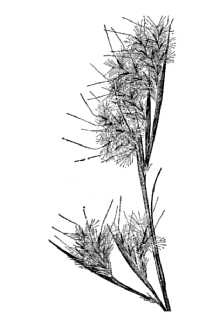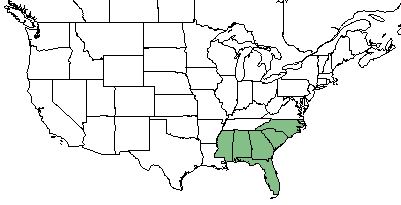Difference between revisions of "Andropogon tracyi"
HaleighJoM (talk | contribs) (→Ecology) |
|||
| (7 intermediate revisions by 5 users not shown) | |||
| Line 19: | Line 19: | ||
}} | }} | ||
==Taxonomic Notes== | ==Taxonomic Notes== | ||
| − | Synonyms: none | + | Synonyms: none.<ref name="weakley">Weakley, A.S. 2015. Flora of the southern and mid-atlantic states. Working Draft of 21 May 2015. University of North Carolina at Chapel Hill, Chapel Hill, North Carolina.</ref> |
| − | Varieties: none | + | Varieties: none.<ref name="weakley">Weakley, A.S. 2015. Flora of the southern and mid-atlantic states. Working Draft of 21 May 2015. University of North Carolina at Chapel Hill, Chapel Hill, North Carolina.</ref> |
==Description== | ==Description== | ||
<!-- Basic life history facts such as annual/perrenial, monoecious/dioecious, root morphology, seed type, etc. --> | <!-- Basic life history facts such as annual/perrenial, monoecious/dioecious, root morphology, seed type, etc. --> | ||
| − | ''A. tracyi'' is a graminoid perennial that is a member of the Poaceae family <ref name= "USDA"> USDA Plants Database URL: https://plants.usda.gov/core/profile?symbol=ANTR </ref>. | + | ''A. tracyi'' is a graminoid perennial that is a member of the Poaceae family <ref name= "USDA"> USDA Plants Database URL: https://plants.usda.gov/core/profile?symbol=ANTR </ref>. Like other species in the genus, ''A. tracyi'' produces chasmogamous flowers with racemes in sets of two, and the peduncles, spikelets, and anthers are considered long in comparison to other ''Andropogon''.<ref name= "Campbell">Campbell, C. S. (1983). "Systematics of the Andropogon virginicus complex (Gramineae)." Journal of the Arnold Arboretum 64(2): 171-254.</ref> |
==Distribution== | ==Distribution== | ||
| − | + | ''Andropogon tracyi'' is endemic to the longleaf pine range from southeastern Virgnia to central Florida and west to southeast Texas.<ref>Sorrie, B. A. and A. S. Weakley 2001. Coastal Plain valcular plant endemics: Phytogeographic patterns. Castanea 66: 50-82.</ref> | |
==Ecology== | ==Ecology== | ||
| Line 34: | Line 34: | ||
The ''Andropogon'' genus is widespread throughout the North American continent, but ''A. tracyi'' is a more rare species found in upland pine communities <ref name= "Gould"> Gould, F. W. (1967). "The Grass Genus Andropogon in the United States." Brittonia 19(1): 70-76. </ref>. It can be found in habitats ranging from disturbed sites like dry loamy sand along roads, and banks along highways, to natural habitats such as scrub oak barrens, dry ridges, high sandy ridges, and other sandy loams. <ref name= "Herbarium"> Florida State University Robert K. Godfrey Herbarium database. URL: http://herbarium.bio.fsu.edu. Last accessed: June 2014. Collectors: Loran C. Anderson, R. K. Godfrey, R. Kral, H. Grelen, Sidney McDaniel, and Bob Farley. States and counties: Florida: Walton, Putnam, Calhoun, Columbia, Wakulla, and Jackson. </ref> | The ''Andropogon'' genus is widespread throughout the North American continent, but ''A. tracyi'' is a more rare species found in upland pine communities <ref name= "Gould"> Gould, F. W. (1967). "The Grass Genus Andropogon in the United States." Brittonia 19(1): 70-76. </ref>. It can be found in habitats ranging from disturbed sites like dry loamy sand along roads, and banks along highways, to natural habitats such as scrub oak barrens, dry ridges, high sandy ridges, and other sandy loams. <ref name= "Herbarium"> Florida State University Robert K. Godfrey Herbarium database. URL: http://herbarium.bio.fsu.edu. Last accessed: June 2014. Collectors: Loran C. Anderson, R. K. Godfrey, R. Kral, H. Grelen, Sidney McDaniel, and Bob Farley. States and counties: Florida: Walton, Putnam, Calhoun, Columbia, Wakulla, and Jackson. </ref> | ||
| − | ===Phenology=== <!--Timing off flowering, fruiting | + | ===Phenology=== <!--Timing off flowering, fruiting, and environmental triggers. Cite PanFlora website if appropriate: http://www.gilnelson.com/PanFlora/ --> |
''A. tracyi'' has been seen to be flowering during the month of November, and fruiting during the same time period. <ref name= "Herbarium"/> | ''A. tracyi'' has been seen to be flowering during the month of November, and fruiting during the same time period. <ref name= "Herbarium"/> | ||
| + | |||
<!--===Seed dispersal===--> | <!--===Seed dispersal===--> | ||
<!--===Seed bank and germination===--> | <!--===Seed bank and germination===--> | ||
| Line 41: | Line 42: | ||
<!--===Pollination===--> | <!--===Pollination===--> | ||
| − | === | + | ===Herbivory and toxicology===<!--Herbivory, granivory, insect hosting, etc.--> |
| − | ''A. tracyi'' is used by quail species in the community for nesting, providing protection for the young from predators <ref name= "Harshbarger"> Harshbarger, T. J. and R. C. Simpson (1970). Late-summer nesting sites of quail in south Georgia, Southeastern Forest Experiment Station, U.S. Department of Agriculture, Forest Service. </ref> | + | ''A. tracyi'' is used by quail species in the community for nesting, providing protection for the young from predators.<ref name= "Harshbarger"> Harshbarger, T. J. and R. C. Simpson (1970). Late-summer nesting sites of quail in south Georgia, Southeastern Forest Experiment Station, U.S. Department of Agriculture, Forest Service. </ref> |
| + | |||
<!--==Diseases and parasites==--> | <!--==Diseases and parasites==--> | ||
| − | ==Conservation and | + | ==Conservation, cultivation, and restoration== |
| − | == | + | ==Cultural use== |
==Photo Gallery== | ==Photo Gallery== | ||
<gallery widths=180px> | <gallery widths=180px> | ||
</gallery> | </gallery> | ||
==References and notes== | ==References and notes== | ||
Latest revision as of 14:08, 15 June 2022
Common name: Tracy's bluestem
| Andropogon tracyi | |
|---|---|

| |
| Photo by the Atlas of Florida Plants Database | |
| Scientific classification | |
| Kingdom: | Plantae |
| Division: | Magnoliophyta - Flowering plants |
| Class: | Liliopsida - Moncots |
| Order: | Cyperales |
| Family: | Poaceae |
| Genus: | Andropogon |
| Species: | A. tracyi |
| Binomial name | |
| Andropogon tracyi Nash | |

| |
| Natural range of Andropogon tracyi from USDA NRCS Plants Database. | |
Contents
Taxonomic Notes
Synonyms: none.[1]
Varieties: none.[1]
Description
A. tracyi is a graminoid perennial that is a member of the Poaceae family [2]. Like other species in the genus, A. tracyi produces chasmogamous flowers with racemes in sets of two, and the peduncles, spikelets, and anthers are considered long in comparison to other Andropogon.[3]
Distribution
Andropogon tracyi is endemic to the longleaf pine range from southeastern Virgnia to central Florida and west to southeast Texas.[4]
Ecology
Habitat
The Andropogon genus is widespread throughout the North American continent, but A. tracyi is a more rare species found in upland pine communities [5]. It can be found in habitats ranging from disturbed sites like dry loamy sand along roads, and banks along highways, to natural habitats such as scrub oak barrens, dry ridges, high sandy ridges, and other sandy loams. [6]
Phenology
A. tracyi has been seen to be flowering during the month of November, and fruiting during the same time period. [6]
Herbivory and toxicology
A. tracyi is used by quail species in the community for nesting, providing protection for the young from predators.[7]
Conservation, cultivation, and restoration
Cultural use
Photo Gallery
References and notes
- ↑ 1.0 1.1 Weakley, A.S. 2015. Flora of the southern and mid-atlantic states. Working Draft of 21 May 2015. University of North Carolina at Chapel Hill, Chapel Hill, North Carolina.
- ↑ USDA Plants Database URL: https://plants.usda.gov/core/profile?symbol=ANTR
- ↑ Campbell, C. S. (1983). "Systematics of the Andropogon virginicus complex (Gramineae)." Journal of the Arnold Arboretum 64(2): 171-254.
- ↑ Sorrie, B. A. and A. S. Weakley 2001. Coastal Plain valcular plant endemics: Phytogeographic patterns. Castanea 66: 50-82.
- ↑ Gould, F. W. (1967). "The Grass Genus Andropogon in the United States." Brittonia 19(1): 70-76.
- ↑ 6.0 6.1 Florida State University Robert K. Godfrey Herbarium database. URL: http://herbarium.bio.fsu.edu. Last accessed: June 2014. Collectors: Loran C. Anderson, R. K. Godfrey, R. Kral, H. Grelen, Sidney McDaniel, and Bob Farley. States and counties: Florida: Walton, Putnam, Calhoun, Columbia, Wakulla, and Jackson.
- ↑ Harshbarger, T. J. and R. C. Simpson (1970). Late-summer nesting sites of quail in south Georgia, Southeastern Forest Experiment Station, U.S. Department of Agriculture, Forest Service.